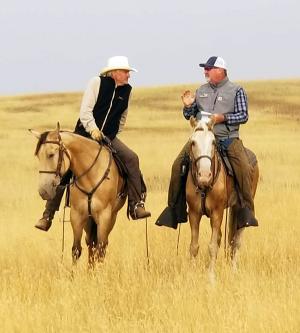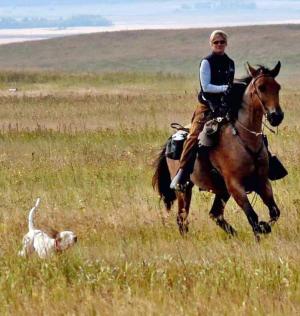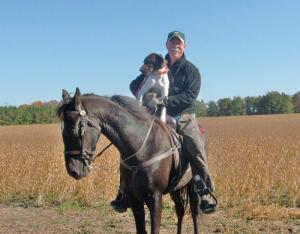By Meredith Mays
In 2008 I received a phone call that would take my equine career to a totally different level. When my phone rang, I did not recognize the number, but I answered it anyway. It was Gary Sheets, who had been referred to me to find him a horse.
Gary was looking for a field trial horse, specifically a Tennessee walking horse. He said that they are hard to find and he was given my number and told I might be able to find a prospect. At the time I was training American Saddlebreds and Arabians, and I had never had the opportunity to work with a Tennessee walker. In addition, I had never heard of field trialing – but he was willing to introduce me to the sport.
Gary explained how field trial horses need to be smooth in their gaits, be able to neck rein, canter, be unscathed by gunfire, ground tie (stay still once the rider dismounts and not leave the spot where it is left), and stake out (be tethered to a stake driven into the ground).
That seemed to be a tall order! Scratching my head, trying to wrap my brain around the type of horse he was looking for, I told him I would call him if I found one. Still skeptical of finding such a horse, I questioned the characteristics he required. Unscathed by gunfire – seriously? Follow a dog? At that time, I was quite unsure I would find the perfect match for him. But time changes everything.
I made some calls and found a black, stocky built, 15.1 hands, 10 year-old gelding who trail rode, had pulled a cart, and was kind. So I hooked up my horse trailer, went and bought him.
Louie was a real sweetie! He showed me what made the Tennessee Walking Horse so special. I came to realize that this is probably to most forgiving breed in the horse world. The fact that they are so forgiving may be the reason why more people aren’t hurt while field trialing.
Louie’s new job was a success and my new equine endeavor took off. I went from 30 head of Saddlebreds standing in tailsets to 80 head of gaited horses, including 5 stallions, 20 brood mares, and a crop of foals in two years. I went from 80 lessons a week to wrangling and giving clinics on riding instead.
At the same time, my education about bird dog field trials began, with Gary starting with the basics. A field trial is a competition for bird dogs. And in bird dog field trials, horses are the primary mode of transportation. Many field trials are held at state wildlife management areas where motorized vehicles aren’t permitted.
In the competition, called a stake, the dogs run in a timed event in pairs, called braces. For each dog there is a handler, a judge, and often a scout. There may also be other people riding along watching the action, who are referred to as the “gallery,” and riders in the gallery must always stay behind the judges.
The handler is the person who is in control of the dog. He or she may use whistles or voice commands to guide the dogs through the set course that everyone in that stake has to follow. The handler’s horse must be a confident, easy to ride individual, since the handler needs to focus on the dog and not be worrying about the horse.
The handler’s horse should obediently ground tie. When the dog scents a bird (quail, chukar, or pheasant), the dog stops and points (freezes in place, tail up, sometimes a foot up) to alert the handler that there is a bird or a covey of birds nearby. The handler dismounts and proceeds to walk in the direction the dog is pointing. His horse should stay in place, as if tied to the ground.
A judge’s horse should also be smooth gaited, with the horse’s footfalls placed such that the rider isn’t bounced at all. his is why gaited horses, rather than trotting horses, are preferred. Since a judge will be on the same horse for a few hours, the judge should be somewhat comfortable to be able to concentrate on judging the dogs. It is also important that the judge’s horse stand still while the handler is flushing the birds. A “squirrelly” horse makes it difficult to see the birds.
The scout is a person chosen by the handler to help find the dog. This is my favorite job at a field trial! Sometimes a dog may have turned left instead of right, so the scout’s job is to get the dog’s attention and bring it to the front. A scout’s horse should be fast and sure-footed, and a very confident animal. A whinnying horse, calling out to the other horses, is not preferred because it is important that the scout not interfere with the dog’s work.
Over the past ten years I have not only learned a lot about how to train a field trial horse, but also how to find the right temperament of horse. Choosing a proper field trial mount is not an easy task. I look for a kind, sure-footed, smooth horse, who can adapt to the starting, stopping, and standing that field trialing demands. It is not an easy job for a horse.
When asked the type of horse makes a good field trial horse, I first ask for which aspect of the game the individual wants the horse. A handler’s horse must be a brave, forward horse with a bit more “go than whoa.” A judge’s horse needs to be smooth with quite a bit of stamina. A gallery horse should have a lot more “whoa than go” and should be kid-safe, as should the bird-planter’s horse. A scout’s horse needs to be ready to go at all times, be swift, and sure-footed.
When people come to me in hopes of finding their new mount, I try to match them with the most appropriate horse for them. All too often, I find that what people think they want, and what I know they need, are two different types of horses. This is why a forgiving horse is priceless. Providing new horse owners with dependable and suitable mounts is my top priority and I pride myself on my ability to determine their needs. I ride each prospect quite a bit at a field trial before I allow anyone else to ride them. That allows me to know what they will or won’t do.
It can be difficult to find a horse that can adapt to all these roles. Since I have become a provider of field trial horses and a wrangler in the northeast, I prefer to provide horses that are easy to ride. In the past ten years, I have learned that it is not just the Tennessee Walking Horses that can be useful at field trials. Other breeds including, but not limited to, Rocky Mountain, Kentucky Mountain, Spotted Saddle Horse, Standardbreds, Missouri Foxtrotters and even the little horse that goes really fast nowhere – the Paso Fino – will paint the landscape of a field trial. From 17 hands to 13.3 hands, you’ll see a variety of gaited horses, mares and geldings alike.
Every horse is an individual. So even though a horse is primarily a conveyance for a field trailer, take a moment to marvel at how well those that you sit on perform, rather than taking them for granted. You may come to appreciate them in a different light. Here’s to the field trial horse!
About the author: Meredith Mays is the owner and trainer at Double M Gaited Horses in Butler, Pennsylvania.
In 2008 I received a phone call that would take my equine career to a totally different level. When my phone rang, I did not recognize the number, but I answered it anyway. It was Gary Sheets, who had been referred to me to find him a horse.
Gary was looking for a field trial horse, specifically a Tennessee walking horse. He said that they are hard to find and he was given my number and told I might be able to find a prospect. At the time I was training American Saddlebreds and Arabians, and I had never had the opportunity to work with a Tennessee walker. In addition, I had never heard of field trialing – but he was willing to introduce me to the sport.
Gary explained how field trial horses need to be smooth in their gaits, be able to neck rein, canter, be unscathed by gunfire, ground tie (stay still once the rider dismounts and not leave the spot where it is left), and stake out (be tethered to a stake driven into the ground).
That seemed to be a tall order! Scratching my head, trying to wrap my brain around the type of horse he was looking for, I told him I would call him if I found one. Still skeptical of finding such a horse, I questioned the characteristics he required. Unscathed by gunfire – seriously? Follow a dog? At that time, I was quite unsure I would find the perfect match for him. But time changes everything.
I made some calls and found a black, stocky built, 15.1 hands, 10 year-old gelding who trail rode, had pulled a cart, and was kind. So I hooked up my horse trailer, went and bought him.
Louie was a real sweetie! He showed me what made the Tennessee Walking Horse so special. I came to realize that this is probably to most forgiving breed in the horse world. The fact that they are so forgiving may be the reason why more people aren’t hurt while field trialing.
Louie’s new job was a success and my new equine endeavor took off. I went from 30 head of Saddlebreds standing in tailsets to 80 head of gaited horses, including 5 stallions, 20 brood mares, and a crop of foals in two years. I went from 80 lessons a week to wrangling and giving clinics on riding instead.
At the same time, my education about bird dog field trials began, with Gary starting with the basics. A field trial is a competition for bird dogs. And in bird dog field trials, horses are the primary mode of transportation. Many field trials are held at state wildlife management areas where motorized vehicles aren’t permitted.
In the competition, called a stake, the dogs run in a timed event in pairs, called braces. For each dog there is a handler, a judge, and often a scout. There may also be other people riding along watching the action, who are referred to as the “gallery,” and riders in the gallery must always stay behind the judges.
The handler is the person who is in control of the dog. He or she may use whistles or voice commands to guide the dogs through the set course that everyone in that stake has to follow. The handler’s horse must be a confident, easy to ride individual, since the handler needs to focus on the dog and not be worrying about the horse.
The handler’s horse should obediently ground tie. When the dog scents a bird (quail, chukar, or pheasant), the dog stops and points (freezes in place, tail up, sometimes a foot up) to alert the handler that there is a bird or a covey of birds nearby. The handler dismounts and proceeds to walk in the direction the dog is pointing. His horse should stay in place, as if tied to the ground.
A judge’s horse should also be smooth gaited, with the horse’s footfalls placed such that the rider isn’t bounced at all. his is why gaited horses, rather than trotting horses, are preferred. Since a judge will be on the same horse for a few hours, the judge should be somewhat comfortable to be able to concentrate on judging the dogs. It is also important that the judge’s horse stand still while the handler is flushing the birds. A “squirrelly” horse makes it difficult to see the birds.
The scout is a person chosen by the handler to help find the dog. This is my favorite job at a field trial! Sometimes a dog may have turned left instead of right, so the scout’s job is to get the dog’s attention and bring it to the front. A scout’s horse should be fast and sure-footed, and a very confident animal. A whinnying horse, calling out to the other horses, is not preferred because it is important that the scout not interfere with the dog’s work.
Over the past ten years I have not only learned a lot about how to train a field trial horse, but also how to find the right temperament of horse. Choosing a proper field trial mount is not an easy task. I look for a kind, sure-footed, smooth horse, who can adapt to the starting, stopping, and standing that field trialing demands. It is not an easy job for a horse.
When asked the type of horse makes a good field trial horse, I first ask for which aspect of the game the individual wants the horse. A handler’s horse must be a brave, forward horse with a bit more “go than whoa.” A judge’s horse needs to be smooth with quite a bit of stamina. A gallery horse should have a lot more “whoa than go” and should be kid-safe, as should the bird-planter’s horse. A scout’s horse needs to be ready to go at all times, be swift, and sure-footed.
When people come to me in hopes of finding their new mount, I try to match them with the most appropriate horse for them. All too often, I find that what people think they want, and what I know they need, are two different types of horses. This is why a forgiving horse is priceless. Providing new horse owners with dependable and suitable mounts is my top priority and I pride myself on my ability to determine their needs. I ride each prospect quite a bit at a field trial before I allow anyone else to ride them. That allows me to know what they will or won’t do.
It can be difficult to find a horse that can adapt to all these roles. Since I have become a provider of field trial horses and a wrangler in the northeast, I prefer to provide horses that are easy to ride. In the past ten years, I have learned that it is not just the Tennessee Walking Horses that can be useful at field trials. Other breeds including, but not limited to, Rocky Mountain, Kentucky Mountain, Spotted Saddle Horse, Standardbreds, Missouri Foxtrotters and even the little horse that goes really fast nowhere – the Paso Fino – will paint the landscape of a field trial. From 17 hands to 13.3 hands, you’ll see a variety of gaited horses, mares and geldings alike.
Every horse is an individual. So even though a horse is primarily a conveyance for a field trailer, take a moment to marvel at how well those that you sit on perform, rather than taking them for granted. You may come to appreciate them in a different light. Here’s to the field trial horse!
About the author: Meredith Mays is the owner and trainer at Double M Gaited Horses in Butler, Pennsylvania.












